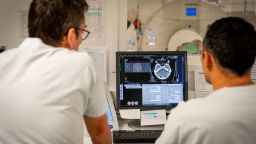FYI.
Stroke presents differently in women than men. Here are 7 symptoms to look for
People often say “time is money,” but talk to any neurologist and they’ll tell you time is brain. Because when it comes to strokes, every minute counts.
“The brain is very sensitive to injury,” said Dr. Eliza Miller, a neurologist at NewYork-Presbyterian/Columbia University Irving Medical Center. The human brain houses 86 billion neurons. For every minute that passes, a person having a stroke loses 1.9 million of them, according to research from the American Heart Association.
Quickly recognizing the signs of stroke is one of the best ways to save a life. BE-FAST is the go-to mnemonic for identifying a stroke. It stands for balance loss, eyesight changes, face drooping, arm weakness, speech difficulty and time to call 911.
While BE-FAST helps with finding the most common symptoms of stroke, it may not reflect the stroke experience of all people. A growing body of research is now showing that women frequently present with atypical symptoms that are more subtle and vague, according to Dr. Hera Kamdar, an assistant professor of neurology at The Ohio State University Wexner Medical Center.
Stroke is the fifth leading cause of death in women, according to the US Centers for Disease Control and Prevention, and Kamdar believes unusual and overlooked symptoms are a contributor to the high mortality rate. Learning the signs could be the difference between making a full recovery and the worst-case scenarios: permanent disability or even death.
Overlooked signs of stroke in women
Beyond the symptoms listed in the BE-FAST mnemonic, Kamdar says some less noticeable signs of stroke seen in women include severe headache, generalized weakness, generalized fatigue, shortness of breath and chest pains, nausea and vomiting, brain fog and hiccups.
Kamdar said these symptoms appear suddenly, may be confused for another health issue, and may not present on only one side of the body (one-sided muscle weakness is common in people experiencing a stroke). Additionally, these symptoms would not improve over time.
Some symptoms on the list, like hiccups, might seem random at first glance. However, there is some research suggesting stroke-related hiccups may be a sign of brain damage to areas like the medulla oblongata, which controls breathing, and the supratentorial cortex, which is involved in the control of movement.
This doesn’t mean every woman should fear for her life every time they get the hiccups or feel drowsy. The symptoms become cause for concern when they are severe enough to impair your functionality, like feeling so weak and tired you are physically unable to get out of bed. Similarly, “every hiccup is not a stroke,” Kamdar said, but it becomes worrisome if it i hurting your throat or is in combination with other symptoms, such as vomiting.
Stroke symptoms in men vs. women
Scientists have come up with several theories for why men and women experience stroke differently. First, it’s all about hormones.
Estrogen is one of the main female reproductive hormones in the body, ongoing research shows it is protective against stroke. This may have to do with estrogen’s anti-inflammatory effects, which could protect against a brain injury. Estrogen also seems to help with increasing blood flow in the internal carotid artery, which supplies blood to the brain.
However, these hormonal benefits apply only to estrogen made in the body. Kamdar said taking synthetic forms of estrogen, whether through birth control or hormone replacement therapy, can actually increase the risk of stroke. Though the elevated risk remains small — 8.5 out of every 100,000 women will experience a stroke because of birth control.
“It’s not that people shouldn’t take birth control, it’s that people with other (stroke) risk factors shouldn’t use this type of contraceptive,” Miller added.
Age is another factor. Women also start making less estrogen as they get older, which could partially explain why the lifetime risk of stroke is higher in women than in men. Research suggests the substantial drop in estrogen levels during menopause is associated with an increased risk of stroke later in life. If women are outliving men, they also have more time and opportunity to have a stroke, Miller added.
Finally, pregnancy can triple the risk of stroke in young women, said Miller. This is because 10% of pregnant people in the United States develop a blood pressure condition called preeclampsia, which raises the risk of stroke.
“This is also true in the postpartum period, especially if the hypertension is not detected or not treated adequately,” Miller noted.
Another factor contributing to the high risk of stroke during pregnancy is blood clots. Miller said human blood has evolved to form blood clots — especially around the time of giving birth — to keep moms from bleeding to death during delivery.
Of course, not everyone who goes through pregnancy gets a blood clot, but Miller said “compared to someone who is not pregnant or postpartum, the risk is far higher during this time.”
What to do if you think you’re having a stroke
Both neurologists said the rate of recovery from stroke depends on how fast a person seeks help for themselves or a loved one. There are treatments available to improve the survival outcomes for stroke, Kamdar said, but they are all time sensitive.
Even if you’re unsure whether someone is having a stroke, Miller advised calling 911 anyway.
“I would rather have a person come into the emergency room and turn out to be completely fine than not come at all and we missed our opportunity to treat the stroke,” Miller said.


No comments:
Post a Comment